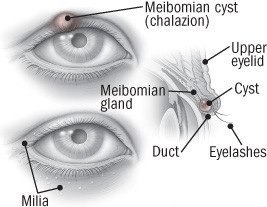Blepharitis
Medically reviewed by Drugs.com. Last updated on Jul 7, 2025.
What is Blepharitis?

Blepharitis is an inflammation of the eyelids that involves the edges of the eyelids and eyelash hair follicles. Blepharitis is a common and sometimes long-lasting condition that usual affects adults, but also can occur in children.
People with skin conditions such as rosacea, seborrhea, oily skin, dandruff or dry eyes are more likely to get this condition.
Blepharitis can be triggered by bacterial infections or by the eyelid glands making too much oil. This condition is not contagious.
Symptoms
The symptoms of blepharitis can include any or all of the following:
- mucus at the corner of the eyes when you wake up
- upper and lower eyelids that appear greasy
- a crust that clings to the lashes
- itching
- burning
- a feeling that something is in your eye when you blink
- red and swollen eyes
- missing lashes or lashes that turn inward
- irritation or breakdown of the skin along the edges of the eyelids
- excessive tears.
Diagnosis
Your doctor can diagnose blepharitis based on your symptoms and an examination of your eyelids.
Expected duration
Blepharitis is often a chronic (long-lasting) condition. It is difficult to cure permanently. In most cases, however, the right treatment reduces the symptoms and controls the condition. In addition, symptoms can change over time and disappear for extended periods — months or years — before returning.
Prevention
Good eyelid hygiene can help to prevent blepharitis and usually can control the condition if you have it.
Drugs used to treat this and similar conditions
Treatment

The key treatment for blepharitis is good eyelid hygiene. The following cleansing regimen is recommended twice daily, in the morning and the evening. Once the condition is under control, you can do this cleaning less often. However, you should resume twice-daily cleaning if the symptoms return. To clean your eyelids:
- Loosen crusts and oil debris by placing a clean washcloth dampened with warm water over closed lids for five minutes.
-
If the condition does not improve with cleaning alone, your doctor may prescribe antibiotic eye drops or ointment if there appears to be an infection. Drops containing an anti-inflammatory drug might also help. Create a cleaning solution by mixing three drops of baby shampoo with two or three ounces of warm water.
-
Moisten a washcloth or cotton swab with the cleaning solution and rub the base of the eyelashes to remove loosened skin and crusts.
-
Rinse the lids with warm water and pat gently with a clean, dry towel.
Treatment options
The following list of medications are related to or used in the treatment of this condition.
When to call a professional
Call your doctor if you develop:
- irritated eyelids or skin around the eyes
- red, irritated eyes
- frequent crusting around the lids
- a sensation that something is in the eye
- ongoing symptoms despite appropriate treatment.
Prognosis
Most cases of blepharitis improve promptly once the appropriate treatment is started. Often treatment must be continued for a long time or repeated from time to time. Blepharitis does not cause permanent damage to sight.
Additional info
American Academy of Ophthalmology
https://www.ao.org
National Eye Institute
https://www.nei.nih.gov
Further information
Always consult your healthcare provider to ensure the information displayed on this page applies to your personal circumstances.
